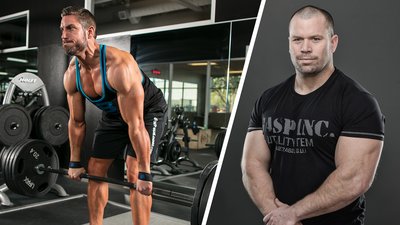Q: I've been feeling like my strength gains have plateaued in the last couple of months. Some people are telling me that by doing partial reps I can get more growth. Is that true?
As a general rule, "full range of motion for full development" is a reliable guideline for building above-average strength and a respectable physique. No matter if you aspire to become a world-class powerlifter, win Mr. Olympia, or just be the biggest, strongest version of yourself, you should stick to full ROM most of the time.
But, if your goal is to truly maximize your strength, there's definitely a time and a place in your training for partials—but it's a secondary place.
How Partials Work
The technique of doing partial reps is based on what is known as the "accentuation principle," which states that you get the most gain by training in the range of motion where the highest amounts of force production are possible. It all comes down to this: by lifting through only a portion of a movement path, you're able to lift more weight—sometimes a hell of a lot more—than you could on a full range of motion, one-repetition max.
However, there's a psychological benefit to doing partials, as well as the physiological one. As anyone who has been under a truly heavy barbell knows, both aspects are crucial.

Psychologically, you can also use partials to help you be more confident when you handle heavy weights. That 250-pound bench press? It'll feel much more approachable if you've already done board presses with 100 pounds more than that in training. Think about the psychological edge you'll have if you attempt a 375-pound squat after having done a half squat with 500 pounds. All of a sudden, 375 is no longer quite so scary.
Physiologically, your body benefits from a little familiarity as well. Our bodies have a kind of built-in regulator, called the Golgi tendon organ, that is meant to protect our muscles from excessive loads. The GTO is a proprioceptive sensory organ that senses changes in muscle tension, then inhibits force production when too much tension is sensed. Normally, this is a good thing. But, if you're after serious strength development, the GTO can definitely get in the way.
In my experience, extreme, heavy partials, done consistently and over time, can desensitize the GTO. By making heavy partials a regular part of your workout, you can train your body to overcome this built-in regulator so you can lift more weight. But, this only works if you do them right—and they are harder to do right than you might think.
The Problem With Partials
Much like isometrics, partials offer the most transference into the range of motion where they're trained. That limits their usefulness to a certain degree. But what's far more damaging is the way most people perform partials: They alter their technique so much that they turn it into an entirely different lift, not just a different ROM, than the one they're trying to strengthen.

Let's say you consistently miss deadlifts three inches above your knees—the spot at which your legs are usually fully extended and your back is somewhat rounded. The standard solution would be to train partial deadlifts in the power rack. So how would you set up those partials? Most likely, you'd start at the exact spot where you miss, then do a quarter squat to the deadlift lockout position, all the while making sure you keep your back perfectly flat.
Sorry, that's not a deadlift lockout. Training this position might send your ego to the penthouse—but your deadlift could still be in the outhouse. Instead of eliminating the sticking point, you've changed the lift into a completely different movement with complete leverages. In effect, you've trained a range of motion you never actually encounter.
The Right Way to Partial
The work you do with partials will help you get past sticking points if, and only if, you do the partial lift using the same mechanics as the full lift. That's why it can be a good idea to do your partials right after you complete the main movement, so that the movement pattern is still fresh. If you're doing deadlifts and your technique is good, do partial deadlifts right after you finish your full range of motion deadlifts.
In the case of the deadlift, though, if you have any doubt about your partial technique—and most people should—you'd be better off improving your deadlift set-up. Most likely the error that led to the sticking point started at the bottom of the lift, and only manifested itself at that point three inches above the knee.
If this is the case, you'd benefit more by strengthening the potentially weak muscle groups by adding band or chain resistance to your deadlifts. These techniques will enable you to work through a full ROM, but will overload your muscles at the specific point in the ROM where you need more strength to help you past the sticking point. Think of them as a modified partial.

